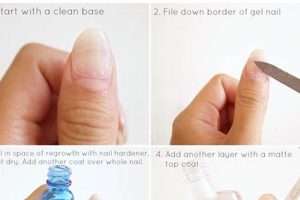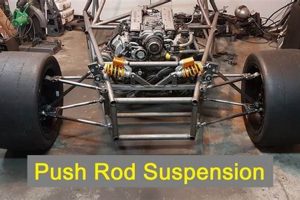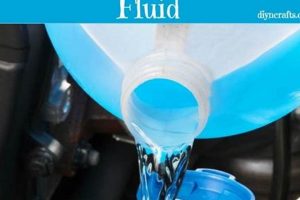The practice of fixing minor vehicle body damage at home, without professional assistance, involves various techniques and tools designed to restore the original shape of the affected area. An example is using a heat gun and compressed air to manipulate the metal back into its original position.
Undertaking these repairs offers potential cost savings and increased convenience compared to professional auto body shop services. Historically, improvised methods were common, but modern approaches often involve specialized kits and online tutorials, providing a more structured approach to the process.
The subsequent discussion will delve into the specific tools, techniques, and safety considerations involved in performing these types of repairs, as well as assess the limitations and potential risks associated with self-performed vehicle damage restoration.
Tips for Effective DIY Dent Repair
This section provides guidance to achieve optimal results when attempting vehicle bodywork restoration independently. Careful planning and execution are critical.
Tip 1: Thoroughly Assess the Damage. Before beginning, examine the extent of the damage, including size, depth, and location. This assessment informs the choice of tools and techniques required.
Tip 2: Clean the Affected Area. Use soap and water, followed by a degreaser, to remove dirt, wax, and other contaminants. This ensures proper adhesion of tools or repair materials.
Tip 3: Select Appropriate Tools. Numerous tools are available, including dent pullers, heat guns, rubber mallets, and specialized glue. Choose tools suited for the specific type and severity of the damage.
Tip 4: Apply Heat Carefully. When using heat guns, maintain a safe distance and use a sweeping motion to avoid overheating the paint, which can cause blistering or discoloration.
Tip 5: Utilize Leverage Techniques. When using dent pullers, apply steady, controlled pressure. Avoid sudden jerks, which can exacerbate the damage.
Tip 6: Work in Small Increments. Gradually work the metal back into shape, rather than attempting to fix it all at once. This minimizes the risk of overcorrection.
Tip 7: Inspect and Refine. After each step, carefully inspect the progress. Use a light source to reveal imperfections and make adjustments as needed.
Tip 8: Protect Surrounding Areas. Use masking tape and protective sheeting to shield adjacent panels from accidental damage during the repair process.
Following these guidelines can improve the likelihood of a successful outcome. However, certain damage may necessitate professional intervention.
The following section will address safety precautions and potential risks associated with self-performed vehicle body repairs.
1. Tool Selection
The successful execution of at-home vehicle dent restoration hinges significantly on appropriate tool selection. The type, size, and location of the dent dictate the specific instruments required. For example, a small, shallow dent might be effectively addressed with a suction cup puller, while a larger, more complex dent necessitates a slide hammer or a specialized glue pulling system. Choosing the wrong tool can not only prove ineffective but also exacerbate the existing damage, potentially leading to more costly repairs. Improper tool selection can inadvertently stretch the metal or damage the paint finish.
Beyond basic tools, understanding the nuances of specialized instruments is vital. For instance, heat guns, when utilized correctly, can improve metal malleability, facilitating easier manipulation. However, improper use can cause paint blistering or metal warping. Similarly, dent bridges offer controlled pulling force but are not suitable for all dent types or locations. A real-world example involves an individual attempting to remove a sharp dent using a rubber mallet intended for minor imperfections, resulting in further panel deformation. A proper dent puller would have been the right choice in this situation.
In conclusion, effective tool selection constitutes a critical component of successful independent vehicle dent repair. It requires a thorough assessment of the damage, an understanding of available tool capabilities, and careful consideration of potential risks. While cost savings are often a motivation for pursuing this method, it is essential to recognize that inadequate tool selection can lead to increased repair expenses and diminished vehicle value. The investment in appropriate tools is an investment in a more successful outcome, which subsequently improves the overall quality of the repair.
2. Surface Preparation
Surface preparation represents a fundamental precursor to any successful attempt at independent vehicle dent restoration. The integrity and longevity of the repair are directly correlated with the meticulousness of this initial phase. Neglecting proper surface preparation can compromise adhesion, hinder accurate damage assessment, and ultimately result in a substandard outcome.
- Cleaning and Degreasing
The removal of dirt, wax, grease, and other contaminants is paramount. These substances can impede the bonding of repair materials and obscure the true extent of the damage. Using a mild detergent followed by a dedicated degreaser ensures a clean substrate. An example is failing to remove wax, which prevents proper adhesion of dent pulling adhesives, leading to repair failure.
- Paint Assessment
Evaluating the condition of the paint surrounding the dent is crucial. Cracks, chips, or weakened areas require stabilization before commencing repair. Ignoring compromised paint can lead to further damage during the restoration process. An instance of this is attempting to pull a dent on paint with existing cracks, which may cause the paint to peel off or crack.
- Masking and Protection
Protecting adjacent panels and trim with masking tape and protective sheeting minimizes the risk of accidental damage during the repair process. Overspray from repair materials or inadvertent contact with tools can be avoided through proper masking techniques. One case would be accidental scratching of unaffected panels due to the absence of masking, necessitating additional repair work.
- Surface Abrasion (When Appropriate)
In certain cases, light abrasion of the paint surface may be necessary to promote adhesion or feather edges for blending. This should be performed with caution and appropriate abrasive materials to avoid damaging the clear coat. Incorrect abrasion can leave deep scratches, requiring repainting of the affected area.
These facets underscore the importance of diligent surface preparation. Properly executed, it sets the stage for a more effective and durable repair. Conversely, neg
lecting these steps can lead to recurring problems and necessitate costly professional intervention.
3. Heating Application
The application of heat constitutes a significant technique within the scope of self-administered vehicle dent restoration. Controlled heating can modify the metal’s malleability, facilitating easier manipulation and restoration of the original panel shape. This process, however, demands precision and an understanding of material properties to prevent unintended consequences.
- Malleability Enhancement
Heating increases the metal’s pliability, reducing the force needed to reshape it. This is particularly useful for thicker gauge panels or in areas with complex contours. For instance, a heat gun, when properly applied, can soften the metal, allowing a dent puller to work more effectively. Failure to apply sufficient heat may result in ineffective dent removal, whereas excessive heat can compromise the paint finish.
- Paint Consideration
The paint finish exhibits sensitivity to excessive heat. Overheating can lead to blistering, cracking, or discoloration. Maintaining a safe distance and employing a sweeping motion with the heat source mitigates this risk. An example includes using a heat gun for an extended duration at close range, causing irreversible damage to the paint. Careful monitoring of the surface temperature is paramount.
- Heat Source Selection
Various heat sources exist, each with differing characteristics. Heat guns are commonly used due to their portability and adjustable temperature settings. Open flames, such as torches, are generally unsuitable due to the difficulty in controlling heat distribution. Selecting an appropriate heat source aligns with the specific material properties and desired temperature range.
- Thermal Expansion Management
Heating causes metal to expand. Understanding this principle is vital for avoiding overcorrection or panel distortion. Controlled, localized heating minimizes the risk of unwanted expansion. For example, applying heat to a large area of the panel can cause uneven expansion, resulting in warping. Precisely targeting the affected area is crucial for thermal expansion management.
These considerations highlight the intricacies of heat application in DIY dent repair. Employing this technique effectively requires a balance between enhancing metal malleability and mitigating potential damage to the paint finish and underlying structure. Skilled execution of heating application can greatly improve the success rate and overall quality of self-performed dent restoration.
4. Pulling Technique
Pulling technique forms a central pillar of independent vehicle dent restoration. It directly influences the outcome of the restoration process, determining whether the damaged panel reverts to its original form or sustains further deformation. The application of force to extract dents, often employing specialized tools like dent pullers or glue pulling systems, requires precision and a comprehension of the underlying metal characteristics. Incorrect pulling can stretch the metal, create new imperfections, or damage the surrounding paint. For example, excessively forceful pulling using a slide hammer can result in an “oil canning” effect, where the metal becomes permanently distorted. The efficacy of the process is intrinsically linked to the skill and knowledge applied.
Diverse methods exist within the domain of pulling techniques, each suited to particular types of dents and panel locations. For instance, glue pulling is frequently employed on large, shallow dents where access to the back of the panel is restricted. Conversely, lever-based systems are better suited for sharply creased dents, where controlled force application is paramount. The choice of method directly affects the distribution of force and the likelihood of achieving a satisfactory repair. A real-world instance of this is attempting to remove a sharp, creased dent with a suction cup puller, which proves ineffective due to the concentrated nature of the damage. Utilizing an appropriate lever-based system would be the right approach in this scenario.
In conclusion, understanding and properly executing pulling techniques is paramount for success in self-performed vehicle dent repair. The integration of appropriate methods, careful application of force, and awareness of potential pitfalls are essential to achieve the desired outcome. Improper technique can lead to further damage, increased repair costs, and a diminished vehicle value. Consequently, the investment in acquiring the relevant skills and knowledge is crucial for successful and cost-effective dent removal.
5. Finishing Methods
The implementation of proper finishing methods constitutes a critical stage in independent vehicle dent repair. These techniques address imperfections remaining after the primary dent removal process, ensuring a seamless transition between the repaired area and the original panel. The quality of the finish directly impacts the aesthetic appeal and long-term durability of the repair. Attention to detail during this phase is essential for achieving a professional-looking result.
- Surface Leveling
Surface leveling involves the use of body fillers or glazing putties to smooth out minor imperfections and create a uniform surface. These materials fill in low spots and blend the repaired area with the surrounding panel. An example includes applying body filler to correct slight indentations or irregularities after dent pulling. Improper leveling can result in visible seams or an uneven texture, detracting from the overall appearance.
- Sanding and Blending
Sanding is used to shape and refine the body filler, creating a smooth transition between the repaired area and the original paint. Progressively finer grades of sandpaper are employed to eliminate scratches and prepare the surface for painting. Failing to properly sand can result in visible imperfections, such as swirl marks or uneven edges, impacting the paint finish.
- Priming
Priming involves applying a coat of primer to the sanded surface. The primer provides a uniform base for the paint, enhances adhesion, and helps to seal the body filler. Neglecting to prime can lead to poor paint adhesion, color inconsistencies, or the appearance of imperfections over time. The correct type of primer must be selected to be compatible with the body filler and paint system.
- Paint Application
The application of paint involves matching the original vehicle color and applying several thin coats of paint to the primed surface. Proper technique is essential to avoid runs, drips, or an uneven finish. Color matching errors can create visible discrepancies, detracting from the overall aesthetic. Clear coat application is necessary to protect the paint and provide a glossy finish.
These finishing methods underscore the importance of meticulous attention to detail in DIY dent repair. The successful integration of these techniques can transform a rudimentary dent repair into a restor
ation that is both aesthetically pleasing and structurally sound, preserving the vehicle’s value and appearance.
6. Damage Assessment
The viability and success of independent vehicle dent restoration are intrinsically linked to the precision and thoroughness of the initial damage assessment. This process involves a detailed examination of the dent, encompassing its size, depth, location, and the characteristics of the surrounding panel. The cause of the damage is also a significant factor. For instance, a sharp dent caused by a small object requires a different approach than a broad, shallow dent resulting from a parking lot incident. Incorrectly assessing these factors can lead to the selection of inappropriate tools and techniques, resulting in a failed or even worsened repair. As a consequence, the damage assessment serves as the foundational component of any DIY dent repair undertaking.
Accurate assessment extends beyond merely identifying the visual imperfections. It includes evaluating the condition of the paint, the presence of underlying structural damage, and the accessibility of the dent from the back of the panel. Ignoring pre-existing paint damage, such as cracks or chips, can lead to further paint delamination during the repair process. Similarly, neglecting to determine whether the dent is accessible from behind might render certain pulling techniques ineffective. A practical example is attempting to pull a dent on a panel with underlying corrosion; the pulling action can exacerbate the corrosion and compromise the structural integrity of the panel, necessitating a more extensive and costly repair. The damage assessment dictates the subsequent steps, including tool selection, repair strategy, and the likelihood of achieving a satisfactory outcome.
In conclusion, proper damage assessment is not merely a preliminary step; it is an integral component of successful DIY dent repair. It informs the entire process, mitigating the risk of misapplication of techniques, and contributing to both the effectiveness and longevity of the repair. Understanding the practical significance of this connection enables individuals to make informed decisions, potentially saving time, resources, and preventing further damage to their vehicles.
7. Safety Protocols
Adherence to safety protocols is paramount in DIY dent repair due to the inherent risks associated with the tools and techniques employed. Failure to implement appropriate safety measures can result in physical injury, property damage, or both. The use of heat guns, power tools, and potentially hazardous chemicals necessitates a stringent approach to safety. Cause-and-effect relationships are evident: improper use of a heat gun can lead to severe burns, while neglecting to wear eye protection can result in eye injuries from flying debris. Safety protocols are not merely a supplementary consideration but a fundamental component of the process.
Real-life examples underscore the importance of these precautions. Individuals who forgo eye protection while sanding body filler risk corneal abrasions or permanent vision damage. Neglecting to disconnect the vehicle’s battery before welding can lead to electrical shocks or damage to the vehicle’s electrical system. The practical significance of understanding these protocols lies in the prevention of avoidable accidents and the mitigation of potential long-term health consequences. Furthermore, failure to adhere to safety regulations can render insurance coverage null and void in the event of an accident.
The implementation of safety protocols presents inherent challenges, including the need for comprehensive training, the availability of appropriate safety equipment, and the consistent enforcement of safety practices. Despite these challenges, the potential benefitsreduced risk of injury, property damage, and legal liabilitiesoutweigh the costs. In conclusion, safety protocols represent an indispensable element of effective DIY dent repair, ensuring both the well-being of the individual and the integrity of the vehicle.
Frequently Asked Questions Regarding DIY Dent Repair
This section addresses common inquiries and concerns surrounding the practice of self-performed vehicle dent restoration. The information provided aims to clarify misconceptions and offer guidance based on industry best practices.
Question 1: Is DIY dent repair suitable for all types of vehicle damage?
No, the suitability of DIY dent repair is contingent upon the nature and extent of the damage. Minor dents and dings, characterized by shallow depressions and intact paint, are often amenable to self-repair. However, larger dents, creases, or damage involving compromised paint or underlying structural issues typically necessitate professional intervention.
Question 2: What are the potential risks associated with attempting DIY dent repair?
Potential risks include exacerbating the damage, damaging the paint finish, compromising the structural integrity of the panel, and personal injury from improper tool usage. A thorough understanding of the techniques and tools is crucial to minimize these risks.
Question 3: What is the importance of proper surface preparation before initiating dent repair?
Proper surface preparation is critical for ensuring proper adhesion of repair materials and accurate assessment of the damage. Failure to clean and degrease the area can compromise the repair’s longevity and aesthetic outcome.
Question 4: How does heat application aid in the dent repair process, and what are the associated precautions?
Controlled heat application enhances metal malleability, facilitating easier reshaping. However, excessive heat can damage the paint finish. A heat gun should be used with caution, maintaining a safe distance and employing a sweeping motion to avoid overheating.
Question 5: What is the significance of selecting the correct tools for DIY dent repair?
Selecting the appropriate tools is crucial for achieving effective and safe dent removal. Utilizing incorrect tools can exacerbate the damage or lead to personal injury. The tool selection should be based on the type, size, and location of the dent.
Question 6: Can DIY dent repair completely restore a vehicle’s panel to its original condition?
While DIY dent repair can significantly improve the appearance of damaged panels, achieving a flawless, factory-like finish is often challenging. The quality of the outcome depends on the individual’s skill, the tools used, and the nature of the damage. Professional repair services typically offer superior results.
In summary, DIY dent repair presents a viable option for addressing minor vehicle damage, but requires careful consideration of the risks, limitations, and the need for proper techniques and tools. When the degree of damage is more extensive, then the services of a qualified technician are required.
The subsequent section will provide a comparative analysis of DIY versus professional dent repair services.
Conclusion
The preceding exploration of DIY dent repair reveals both its potential advantages and inherent limitations. Self-administered dent restoration can offer cost savings and convenience for minor cosmetic imperfections. However, the success of such endeavors is continge
nt upon proper damage assessment, meticulous technique, and adherence to safety protocols. Improper execution can lead to further damage and increased repair costs.
Ultimately, the decision to pursue DIY dent repair warrants careful consideration. Individuals should weigh their skill level, access to appropriate tools, and the severity of the damage against the potential risks and benefits. When in doubt, seeking professional evaluation and repair remains the prudent course of action to ensure the vehicle’s structural integrity and aesthetic appeal are preserved.







